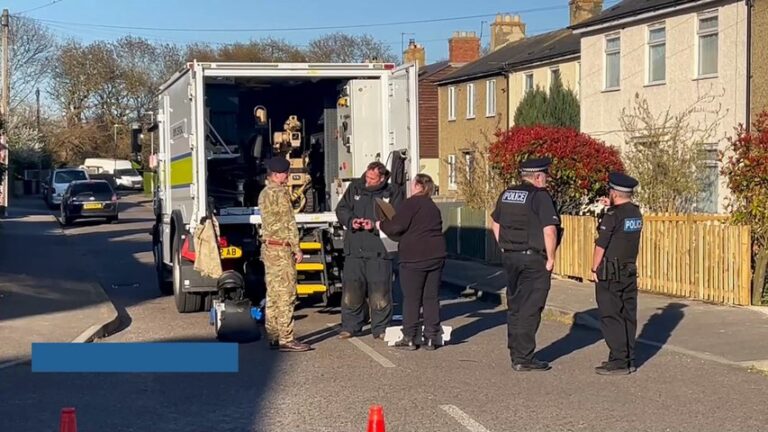On a quiet spring afternoon in Hersden, a small village just outside Canterbury, life was abruptly disrupted. What began as concern over a “suspicious package” escalated into a full bomb-disposal operation and the evacuation of local homes. The shocking headline—IEDs found Hersden Canterbury—gripped residents and drew national attention.
Local police in Kent received the report around 2:05 pm on April 7, 2025. When officers arrived at North View, Hersden, they immediately cordoned off the street, evacuated nearby houses, and called in specialist bomb disposal teams. The presence of a military bomb disposal unit confirmed that authorities were treating the incident with utmost seriousness.
Witnesses later reported that two suspected IEDs had been found beneath cars in the street. As a precaution, residents were told they could not return to their properties until a secondary bomb disposal team arrived.
The Response: Police, EOD, and Evacuation Efforts
From the outset, the response was fast and coordinated. Kent Police established secure perimeters around the affected zone, while the Ministry of Defence’s Explosive Ordnance Disposal (EOD) unit deployed its specialist equipment.
Bomb squads used remote-operated robots, protective gear, and careful procedures to approach the devices. Their goal was to assess, neutralize, and remove the threat without causing harm to people or property.
While the operation proceeded, the evacuated residents remained at a distance, many anxious and uncertain about what was unfolding. Some described a surreal sense of watching bomb disposal activity in what had just hours before been an ordinary suburban street.
Thankfully, public safety was maintained: authorities later confirmed that the seized package was assessed to pose no risk to the public after evaluation.
Arrest and Legal Proceedings
Soon after, law enforcement made a significant arrest. A 37-year-old man, identified as Andrew King, was taken into custody. He was charged with offences including placing an article with intention to cause fear, possession of knife, and possession of cannabis.
A police statement clarified that while the incident triggered counterterror protocols, no counterterror units were formally involved in the probe. King was slated to appear at Margate Magistrates’ Court.
Impact on the Community
For a village like Hersden—with its quiet streets, local shops, and tight community feel—the event was deeply unsettling. Many residents reported frustration and anxiety: some were unable to return home for hours, while others worried over the safety of loved ones.
Local commentary, both in person and online, underlined the sense that this was something no one in the village ever anticipated. The phrase IEDs found Hersden Canterbury became more than a headline—it was a lived moment of disruption for many.
In the aftermath, authorities lifted the cordon and allowed residents back into their homes. Still, the memory lingers: as one resident put it, “It is not a nice situation to be in but safety has to come first.”
Broader Implications: Threats, Preparedness, and Awareness
Though shocking locally, the Hersden incident must be seen within a larger framework: the ongoing risk of improvised explosive devices (IEDs), and how communities and security agencies respond to them.
IEDs are often favored by illicit actors precisely because their components can be sourced or manufactured with relative ease, and their deployment can strike unpredictably. For that reason, law enforcement and counterexplosive units remain on constant alert, training for rapid deployment to mitigate potential harm.
The Hersden case demonstrates how quickly an ordinary neighborhood can transform into an active security zone—and how vital protocols, training, and civilian cooperation become in such moments. Evacuations, cordons, controlled handling of devices, and clear communication all play crucial roles.
Another takeaway is the importance of public awareness. Knowing how to respond when you spot a suspicious package (not touching it, reporting it promptly, keeping distance) can make a difference. Rumors and panic can worsen a situation, so reliance on official channels is key.
Finally, the legal consequences for those who manufacture or place explosive devices—even if ultimately they pose no active threat—are severe. The authorities in the Hersden case wasted no time in making arrests and levying charges.
Conclusion
The discovery of suspected IEDs in Hersden, Canterbury, was a dramatic incursion into what is normally a peaceful corner of the county. While responders succeeded in keeping the danger controlled and no injuries were reported, the disruption and distress inflicted on residents cannot be underestimated.
This episode underscores how communities—even those far from major cities—must remain vigilant, and reinforces the importance of having capable, responsive bomb disposal and police teams ready to act swiftly. It also reminds us that vigilance and public cooperation matter; in times of uncertainty, following official guidance, staying calm, and reporting suspicious items may help prevent tragedy.
